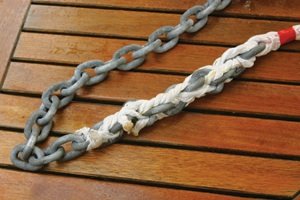How does it pass through your windlass?
There is an alternative to Rope chain splice shown in Maxwell link. See here:
8-Strand splice Page 2 | Sail Magazine
This sort "running" splice seems to generally produce a better transition although obviously Maxwell disagree. Maybe try both and see which works best with your gypsy.
Maxwell have patented a special "wave design" of gypsy to handle both rope and chain. Some independent reports suggest the gypsy works much better than the oppositions attempts. This may explain why they prefer a different splice.
I (actually my wife did the splicing) have spliced 8 plait onto chain (with a running splice) and used this for many years. The splice passed through the gypsy (Muir vertical) quite well although the grip as you would expect was not as secure.
The lack of grip in the transition did occasional cause a problem. One anchorage in Italy where the depth dropped off rapidly we dragged in storm force winds. The depth was over 80m only just outside the anchorage. I could use the capstan to recover the rope but the grip was insufficient for chain. The grip on the chain gypsy was insufficient over the splice area to recover the full weight of the chain and anchor. Not much fun.
These were extreme circumstances, but many boats keep rope rode in reserve to give extra scope in strong wind. The transition between the rope and the chain needs some careful thought. What works well in light wind may not be satisfactory for strong conditions. In these conditions you may need one hand to hold on and communication between the helm and foredeck will be very limited.
Not many anchorages drop off in depth as rapidly as those in Europe, but if you drag you are still likely to be recovering the anchor in much deeper water than normal. The grip on the gypsy needs to at least cope with the weight of the chain from the bow to the bottom. If the bow is blown off while this happening the force will be greater.
Unfortunately, the splice tends to be too bulky to pass through a chain stopper. A short length of rope with a chain hook is helpful in at least securing the chain as the rope/chain splice passes around the gypsy. This way if the splice jumps out the whole length of chain will not drop to the bottom.
Photo showing the sort of splice we used (although not our handiwork)



